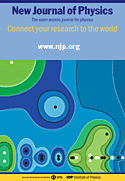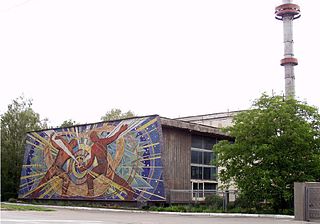
The neutron is a subatomic particle, symbol
n
or
n0
, that has no electric charge, and a mass slightly greater than that of a proton. Protons and neutrons constitute the nuclei of atoms. Since protons and neutrons behave similarly within the nucleus, they are both referred to as nucleons. Nucleons have a mass of approximately one atomic mass unit, or dalton. Their properties and interactions are described by nuclear physics. Protons and neutrons are not elementary particles; each is composed of three quarks.
Nuclear engineering is the engineering discipline concerned with designing and applying systems that utilize the energy released by nuclear processes. The most prominent application of nuclear engineering is the generation of electricity. Worldwide, some 440 nuclear reactors in 32 countries generate 10 percent of the world's energy through nuclear fission. In the future, it is expected that nuclear fusion will add another nuclear means of generating energy. Both reactions make use of the nuclear binding energy released when atomic nucleons are either separated (fission) or brought together (fusion). The energy available is given by the binding energy curve, and the amount generated is much greater than that generated through chemical reactions. Fission of 1 gram of uranium yields as much energy as burning 3 tons of coal or 600 gallons of fuel oil, without adding carbon dioxide to the atmosphere.
Physical Review Letters (PRL), established in 1958, is a peer-reviewed, scientific journal that is published 52 times per year by the American Physical Society. The journal is considered one of the most prestigious in the field of physics. Over a quarter of Physics Nobel Prize-winning papers between 1995 and 2017 were published in it.

The Joint Institute for Nuclear Research, in Dubna, Moscow Oblast, Russia, is an international research center for nuclear sciences, with 5,500 staff members including 1,200 researchers holding over 1,000 Ph.Ds from eighteen countries. Most scientists are scientists of the Russian Federation.

King Abdulaziz City for Science and Technology in Riyadh, Saudi Arabia is a governmental organization established in 1977 as the Saudi Arabian National Center for Science & Technology (SANCST); in 1985, it was renamed King Abdulaziz City for Science and Technology.

The Homi Bhabha National Institute (HBNI) is an Indian deemed university established by the Department of Atomic Energy, which unifies academic programmes of several of its constituent institutions. Deemed universities in India have been divided in three categories by the Ministry of Human Resource Development (MHRD) and HBNI has been placed in category 'A', highest of the three categories. Homi Bhabha National Institute, Mumbai and its Constituent Units are the institutions of excellence as per section 4(b) of "The Central Education Institutions Act, 2006".

The Kurchatov Institute is Russia's leading research and development institution in the field of nuclear energy. It is named after Igor Kurchatov and is located at 1 Kurchatov Square, Moscow.
Dmitri Dmitrievich Ivanenko was a Soviet theoretical physicist of Ukrainian origin who made great contributions to the physical science of the twentieth century, especially to nuclear physics, field theory, and gravitation theory. He worked in the Poltava Gravimetric Observatory of the Institute of Geophysics of NAS of Ukraine, was the head of the Theoretical Department Ukrainian Physico-Technical Institute in Kharkiv, Head of the Department of Theoretical Physics of the Kharkiv Institute of Mechanical Engineering. Professor of University of Kharkiv, Professor of Moscow State University.
The Journal of Physics B: Atomic, Molecular and Optical Physics is a biweekly peer-reviewed scientific journal published by IOP Publishing. It was established in 1968 from the division of the earlier title, Proceedings of the Physical Society. In 2006, the Journal of Optics B: Quantum and Semiclassical Optics was merged with the Journal of Physics B. The editor-in-chief is Marc Vrakking.

New Journal of Physics is an online-only, open-access, peer-reviewed scientific journal covering research in all aspects of physics, as well as interdisciplinary topics where physics forms the central theme. The journal was established in 1998 and is a joint publication of the Institute of Physics and the Deutsche Physikalische Gesellschaft. It is published by IOP Publishing. The editor-in-chief is Andreas Buchleitner (Albert Ludwigs University). New Journal of Physics is part of the SCOAP3 initiative.

A neutron research facility is most commonly a big laboratory operating a large-scale neutron source that provides thermal neutrons to a suite of research instruments. The neutron source usually is a research reactor or a spallation source. In some cases, a smaller facility will provide high energy neutrons using existing neutron generator technologies.

The National Science Center Kharkiv Institute of Physics and Technology (KIPT) (Ukrainian: Національний науковий центр «Харківський фізико-технічний інститут»), formerly the Ukrainian Physics and Technology Institute (UPTI) is the oldest and largest physical science research centre in Ukraine. Today it is known as a science center as it consists of several institutes that are part of the Kharkiv Institute of Physics and Technology science complex.
Dorin Mircea Stelian Poenaru is a Romanian nuclear physicist and engineer. He contributed to the theory of heavy particle radioactivity.

Chinese Physics B is a monthly peer-reviewed scientific journal published in English by IOP Publishing. It is sponsored by the Chinese Physical Society and the Institute of Physics, Chinese Academy of Sciences.

Sir Steven Charles Cowley is a British theoretical physicist and international authority on nuclear fusion and astrophysical plasmas. He has served as director of the United States Department of Energy (DOE) Princeton Plasma Physics Laboratory (PPPL) since 1 July 2018. Previously he served as president of Corpus Christi College, Oxford, since October 2016. and head of the EURATOM / CCFE Fusion Association and chief executive officer of the United Kingdom Atomic Energy Authority (UKAEA). He was appointed chair of the board of trustees of the Faraday Institution in July 2024.

Valangiman Subramanian Ramamurthy is an Indian nuclear physicist with a broad range of contributions from basic research to Science and Engineering administration.Prof.Ramamurthy started his career in Bhabha Atomic Research Centre, Mumbai in the year 1963. He made important research contributions in the area of nuclear fission, medium energy heavy ion reactions, statistical and thermodynamic properties of nuclei and low energy accelerator applications. During the period 1995-2006, Prof.Ramamurthy was fully involved in Science administration as Secretary to Government of India, Department of Science and Technology, (DST), New Delhi.Other important assignments held by him include Director, Institute of Physics, Bhubaneswar, (1989-1995), DAE Homi Bhabha Chair in the Inter-University Accelerator Centre, New Delhi (2006-2010), and Director of the National Institute of Advanced Studies, Bengaluru (2009-2014). He is a former chairman of the Recruitment and Assessment Board of the Council of Scientific and Industrial Research and has served as a member of the design team of the first Indian nuclear experiment in Pokhran on 18 May 1974. The Government of India awarded him the third highest Indian civilian honour of Padma Bhushan in 2005.

Boris Pritychenko is a Russian–American nuclear physicist. He compiles experimental data, works on nuclear databases, and serves as editor-in-chief of the journal Atomic Data and Nuclear Data Tables.
Atomic Data and Nuclear Data Tables is a quarterly peer-reviewed scientific journal covering nuclear physics. It is published by Elsevier and was established in 1969. The journal was established with the aid of Katharine Way, who later served as its editor until 1973. As of 2016, Boris Pritychenko is the journal's editor-in-chief.

Institute for Nuclear Research of the National Academy of Sciences of Ukraine (KINR) is a research institute located in Kyiv, Ukraine. The Institute publishes the journal Nuclear Physics and Atomic Energy.

The All-Russian Scientific Research Institute of Experimental Physics (VNIIEF) is a research institute based in Sarov, Russia and established in 1947. During the Soviet era, it was known as KB-11 and All-Soviet (All-Union) Scientific Research Institute of Experimental Physics. It is currently part of the Rosatom group.












